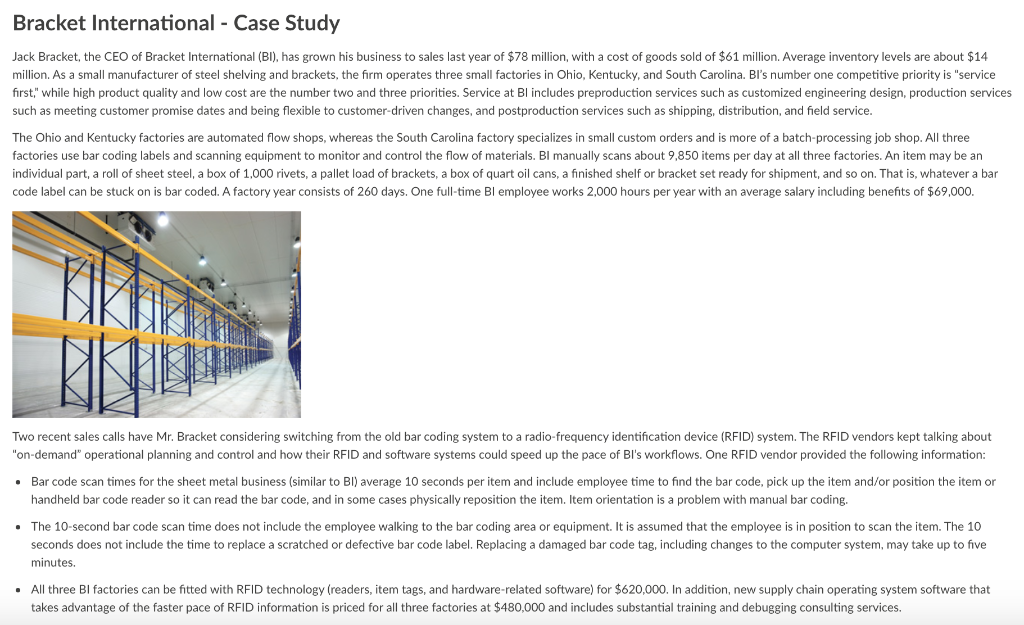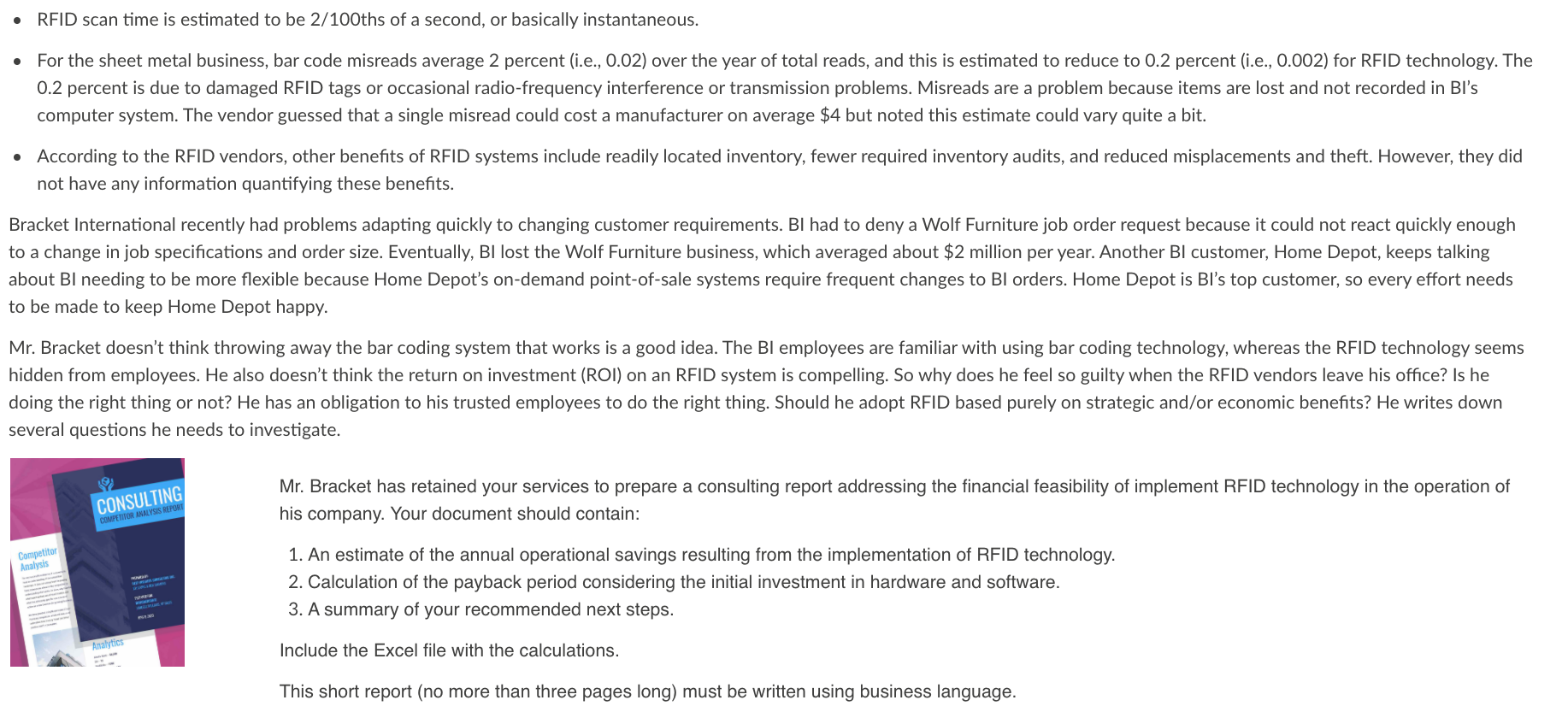

Bracket International - Case Study Jack Bracket, the CEO of Bracket International (BI), has grown his business to sales last year of $78 million, with a cost of goods sold of $61 million. Average inventory levels are about $14 million. As a small manufacturer of steel shelving and brackets, the firm operates three small factories in Ohio, Kentucky, and South Carolina. Bi's number one competitive priority is "service first," while high product quality and low cost are the number two and three priorities. Service at Bl includes preproduction services such as customized engineering design, production services such as meeting customer promise dates and being flexible to customer-driven changes, and postproduction services such as shipping, distribution, and field service. The Ohio and Kentucky factories are automated flow shops, whereas the South Carolina factory specializes in small custom orders and is more of a batch-processing job shop. All three factories use bar coding labels and scanning equipment to monitor and control the flow of materials. Bl manually scans about 9,850 items per day at all three factories. An item may be an individual part, a roll of sheet steel, a box of 1,000 rivets, a pallet load of brackets, a box of quart oil cans, a finished shelf or bracket set ready for shipment, and so on. That is, whatever a bar code label can be stuck on is bar coded. A factory year consists of 260 days. One full-time Bl employee works 2,000 hours per year with an average salary including benefits of $69,000. Two recent sales calls have Mr. Bracket considering switching from the old bar coding system to a radio-frequency identification device (RFID) system. The RFID vendors kept talking about "on-demand operational planning and control and how their RFID and software systems could speed up the pace of Bl's workflows. One RFID vendor provided the following information: Bar code scan times for the sheet metal business (similar to BI) average 10 seconds per item and include employee time to find the bar code, pick up the item and/or position the item or handheld bar code reader so it can read the bar code, and in some cases physically reposition the item. Item orientation is a problem with manual bar coding. The 10-second bar code scan time does not include the employee walking to the bar coding area or equipment. It is assumed that the employee is in position to scan the item. The 10 seconds does not include the time to replace a scratched or defective bar code label. Replacing a damaged bar code tag, including changes to the computer system, may take up to five minutes. All three Bi factories can be fitted with RFID technology (readers, item tags, and hardware-related software) for $620,000. addition, new supply chain operating system software that takes advantage of the faster pace of RFID information is priced for all three factories at $480,000 and includes substantial training and debugging consulting services. RFID scan time is estimated to be 2/100ths of a second, or basically instantaneous. For the sheet metal business, bar code misreads average 2 percent (i.e., 0.02) over the year of total reads, and this is estimated to reduce to 0.2 percent (i.e., 0.002) for RFID technology. The 0.2 percent is due to damaged RFID tags or occasional radio-frequency interference or transmission problems. Misreads are a problem because items are lost and not recorded in Bl's computer system. The vendor guessed that a single misread could cost a manufacturer on average $4 but noted this estimate could vary quite a bit. According to the RFID vendors, other benefits of RFID systems include readily located inventory, fewer required inventory audits, and reduced misplacements and theft. However, they did not have any information quantifying these benefits. Bracket International recently had problems adapting quickly to changing customer requirements. Bl had to deny a Wolf Furniture job order request because it could not react quickly enough to a change in job specifications and order size. Eventually, BI lost the Wolf Furniture business, which averaged about $2 million per year. Another Bl customer, Home Depot, keeps talking about Bl needing to be more flexible because Home Depot's on-demand point-of-sale systems require frequent changes to Bl orders. Home Depot is Bl's top customer, so every effort needs to be made to keep Home Depot happy. Mr. Bracket doesn't think throwing away the bar coding system that works is a good idea. The Bl employees are familiar with using bar coding technology, whereas the RFID technology seems hidden from employees. He also doesn't think the return on investment (ROI) on an RFID system is compelling. So why does he feel so guilty when the RFID vendors leave his office? Is he doing the right thing or not? He has an obligation to his trusted employees to do the right thing. Should he adopt RFID based purely on strategic and/or economic benefits? He writes down several questions he needs to investigate. CONSULTING Mr. Bracket has retained your services to prepare a consulting report addressing the financial feasibility of implement RFID technology in the operation of his company. Your document should contain: COMPETITOR ANALYSIS REPORT Competitor Analysis 1. An estimate of the annual operational savings resulting from the implementation of RFID technology. 2. Calculation of the payback period considering the initial investment in hardware and software. 3. A summary of your recommended next steps. Analytics Include the Excel file with the calculations. This short report (no more than three pages long) must be written using business language. Bracket International - Case Study Jack Bracket, the CEO of Bracket International (BI), has grown his business to sales last year of $78 million, with a cost of goods sold of $61 million. Average inventory levels are about $14 million. As a small manufacturer of steel shelving and brackets, the firm operates three small factories in Ohio, Kentucky, and South Carolina. Bi's number one competitive priority is "service first," while high product quality and low cost are the number two and three priorities. Service at Bl includes preproduction services such as customized engineering design, production services such as meeting customer promise dates and being flexible to customer-driven changes, and postproduction services such as shipping, distribution, and field service. The Ohio and Kentucky factories are automated flow shops, whereas the South Carolina factory specializes in small custom orders and is more of a batch-processing job shop. All three factories use bar coding labels and scanning equipment to monitor and control the flow of materials. Bl manually scans about 9,850 items per day at all three factories. An item may be an individual part, a roll of sheet steel, a box of 1,000 rivets, a pallet load of brackets, a box of quart oil cans, a finished shelf or bracket set ready for shipment, and so on. That is, whatever a bar code label can be stuck on is bar coded. A factory year consists of 260 days. One full-time Bl employee works 2,000 hours per year with an average salary including benefits of $69,000. Two recent sales calls have Mr. Bracket considering switching from the old bar coding system to a radio-frequency identification device (RFID) system. The RFID vendors kept talking about "on-demand operational planning and control and how their RFID and software systems could speed up the pace of Bl's workflows. One RFID vendor provided the following information: Bar code scan times for the sheet metal business (similar to BI) average 10 seconds per item and include employee time to find the bar code, pick up the item and/or position the item or handheld bar code reader so it can read the bar code, and in some cases physically reposition the item. Item orientation is a problem with manual bar coding. The 10-second bar code scan time does not include the employee walking to the bar coding area or equipment. It is assumed that the employee is in position to scan the item. The 10 seconds does not include the time to replace a scratched or defective bar code label. Replacing a damaged bar code tag, including changes to the computer system, may take up to five minutes. All three Bi factories can be fitted with RFID technology (readers, item tags, and hardware-related software) for $620,000. addition, new supply chain operating system software that takes advantage of the faster pace of RFID information is priced for all three factories at $480,000 and includes substantial training and debugging consulting services. RFID scan time is estimated to be 2/100ths of a second, or basically instantaneous. For the sheet metal business, bar code misreads average 2 percent (i.e., 0.02) over the year of total reads, and this is estimated to reduce to 0.2 percent (i.e., 0.002) for RFID technology. The 0.2 percent is due to damaged RFID tags or occasional radio-frequency interference or transmission problems. Misreads are a problem because items are lost and not recorded in Bl's computer system. The vendor guessed that a single misread could cost a manufacturer on average $4 but noted this estimate could vary quite a bit. According to the RFID vendors, other benefits of RFID systems include readily located inventory, fewer required inventory audits, and reduced misplacements and theft. However, they did not have any information quantifying these benefits. Bracket International recently had problems adapting quickly to changing customer requirements. Bl had to deny a Wolf Furniture job order request because it could not react quickly enough to a change in job specifications and order size. Eventually, BI lost the Wolf Furniture business, which averaged about $2 million per year. Another Bl customer, Home Depot, keeps talking about Bl needing to be more flexible because Home Depot's on-demand point-of-sale systems require frequent changes to Bl orders. Home Depot is Bl's top customer, so every effort needs to be made to keep Home Depot happy. Mr. Bracket doesn't think throwing away the bar coding system that works is a good idea. The Bl employees are familiar with using bar coding technology, whereas the RFID technology seems hidden from employees. He also doesn't think the return on investment (ROI) on an RFID system is compelling. So why does he feel so guilty when the RFID vendors leave his office? Is he doing the right thing or not? He has an obligation to his trusted employees to do the right thing. Should he adopt RFID based purely on strategic and/or economic benefits? He writes down several questions he needs to investigate. CONSULTING Mr. Bracket has retained your services to prepare a consulting report addressing the financial feasibility of implement RFID technology in the operation of his company. Your document should contain: COMPETITOR ANALYSIS REPORT Competitor Analysis 1. An estimate of the annual operational savings resulting from the implementation of RFID technology. 2. Calculation of the payback period considering the initial investment in hardware and software. 3. A summary of your recommended next steps. Analytics Include the Excel file with the calculations. This short report (no more than three pages long) must be written using business language








